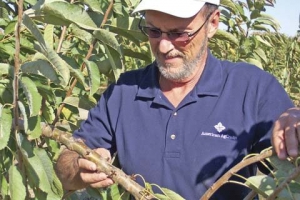 Dave Santos looks at next year’s fruiting buds on an organic Coral Champagne cherry tree. Because synthetic growth regulators can’t be used in organic cherries, lateral branches are tied and cracked to encourage precocity and fruitfulness.
Dave Santos looks at next year’s fruiting buds on an organic Coral Champagne cherry tree. Because synthetic growth regulators can’t be used in organic cherries, lateral branches are tied and cracked to encourage precocity and fruitfulness.
Disease and insects are not the most worrisome pests in the organic blocks of a California stone fruit grower and shipper. Weed management is the bugaboo.
“Weed control is the toughest part of being organic,” said Dave Santos, partner in Lucich and Santos Farms of Patterson, California, one of the state’s largest fresh-market apricot growers and shippers. About 120 acres of their 800 acres of tree fruit are certified organic, with 80 more acres in transition for certification in the coming years.
“We’ve tried mulches, hot foaming weed machines, hot steamers, flamers, and even acetic acid to try to control the weeds,” he said.
The problem with many of the devices is timing, something that is critical in weed management and something that can easily get away from you when you’re busy with other orchard activities, Santos added. For now, they are using a side cutter that works in various stages of weed growth.
Another issue with weed control is the fuel and labor needed to run the weeding equipment. Santos explained that in their search for weed management tools, they also consider the fuel and labor associated with the implement and how often it needs to be run through an orchard.
He noted that close management is needed when growing both conventional and organic fruit. Equipment must be dedicated to the organic blocks to prevent contamination. Organic fruit goes over the packing line first thing in the day after careful washing down and sanitation of the lines the night before and is then followed by conventional fruit.
Ozone, approved for organic use, sanitizes the water used in the packing line because, unlike chlorine, it doesn’t leave a residue. “The ozonator gives us peace of mind with our water,” Santos said.
Growing for the organic market has been an educational experience, he said. “We’re learning a lot of things. And we’re learning that we don’t know very much.”
He noted that there are sufficient organic materials for most insects, although no control is available yet for shothole borer. In the past, organic fungicides were a weak link, but now there are several options to use against mildew and other diseases.
Prunings from the orchard cannot be burned in California. Therefore, brush cutters are used to chop up the prunings, leaving them in the row middles for mulch and organic matter.
“Costs are definitely higher for organic,” Santos said. “Our spray rigs are out there nearly every day, and we spray on shorter intervals.”
They apply compost in their organic blocks at a rate of five tons to the acre. The compost, which includes lime, gypsum, soft rock phosphate, zinc sulfate, and Wondergrow, an organic fertilizer, costs $270 per acre compared to $80 to $100 per acre for conventional fertilizer.
Organic cherries have their own set of challenges, especially when it comes to promoting precocity and early production.
“We can’t use Promalin or latex paint because they are not certified organic products. So we’ve tried tying down laterals and cracking them to encourage bud break, and we use Surround instead of white paint for sunburn protection of the limbs.”
Cracking the limbs is a technique Santos learned from an Australian orchardist.
The irrigation drip line in the organic cherry blocks is buried to keep the lines out of the way of weeding equipment. Converting from flood irrigation to drip dramatically improved water efficiency and reduced water needs from six-acre feet of water used annually for flood irrigation to one-acre foot of water used in drip. With water costs around $50 per acre-foot, the savings are significant.
Santos concedes that their organic market is small, but it continues to grow every year. Their organic clients include Whole Foods, Pacific Organics, Raley’s, Safeway, and NorCal Produce. “Three years ago, Safeway dedicated a half-time buyer to organic fruits and vegetables,” he said. “This past year, they had three full-time buyers.”

Leave A Comment